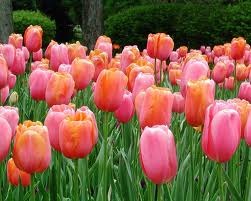Tulips are one of the most well-known of spring flowers, especially in the northern temperate zone of the U.S. They appear in early spring from bulbs planted in the fall. They also have quite a floral history.
They were introduced into Europe from Turkey in 1554 where they instantly became a hit. As a result, Tulipomania in Holland followed in the 17th century. It caused quite a stir among people wishing to get rich from investing in the bulbs. In fact, fabulous prices were paid on a single bulb and vast sums were lost through such speculation.
People may not have become rich from the pursuit, but the flowers still do bring us now, as they did back then, a wealth of beauty come every spring.
Following are the steps needed to grow, care for, and reproduce these striking cup-shaped, popular spring blooms.
- Difficulty:
- Moderately Easy
Instructions
Things You’ll Need
- Tulip bulbs
- Leaf mulch/covering
- Water
- Spade
- Shovel (square head)
- Bonemeal
- Patience
- Plant bulbs, or set out plants any time after September 1, or until the first freeze. The size of the bulb, of course, has an impact on the size of the flower that will be produced. Usually bulbs measuring 1 1/2 inches in diameter will make the best showing.
- Prepare the soil thoroughly by spading it deeply with bonemeal. Try not to use a location where tulips were planted the previous year.
- Dig out the whole area that the bulbs will occupy to a depth of approximately 4 to 6 inches. Place the bulbs in position about 6 inches apart and replace the soil.
- After the ground freezes in late fall, apply a light winter covering to the area where you planted the bulbs, such as a layering or mulch of leaves.
- Remove the winter leaf covering gradually in the spring as the flowers begin to peep through, and water plants.
- After the flowers’ spring display, as soon as the foliage is completely withered, the bulbs should be lifted. Several smaller bulbs will be found at the base or in place of the large planted bulb. These should be stored away in a dry and airy place. After a couple weeks, clean and sort these smaller bulbs as to size and replant. Bulbs 1" or more in diameter normally will produce a flower the following spring.
- Plant smaller bulbs in a separate part of the garden. They will typically yield flowering size bulbs in one to three years time.
Tips & Warnings
-
The longer-stemmed, later spring flowering tulips make their best appearance when planted in front of evergreens or massed in a border of perennials.
-
Tulips grow readily from seed, and this is the means employed for producing new varieties. However, many new kinds also appear naturally as mutations (commonly known as "sports"). That is, a bulb suddenly bears a flower that is different in form or color from its variety or what it’d normally produce. If grown on for another season, and the bulb retains this difference, it may become the nucleus of another new kind of tulip, a stock which is built up by the natural tendency of the plant to develop new small bulbs at the base of the large one. These (except in the case of "sports"), normally, duplicate their parent.
-
The first tulips to appear in the spring are the Single Early group whose stems are relatively short. These flowers are usually less hardy than the later flowering types of tulips. A typical variety, Keiserskroon, has a striking color combination of yellow and red. However, many colors and combinations of colors are available in this class.
-
The second group of tulips that appear in the springtime are the Double Early Group. They are large and have peony-like blooms.
-
Cottage tulips are the last group of tulips to bloom in the spring. A typical cottage tulip is Mrs. Moon which is a tall, handsome plant with, in most cases, a yellow bloom.
-
The planting of mixed colors rarely produces a desirable outcome. If you wish to have a large variety of colors, group or spot plant individual varieties.


Deprecated: strpos(): Passing null to parameter #1 ($haystack) of type string is deprecated in /home/agriviek8Qv/agriviet.net/public_html/wp-includes/comment-template.php on line 2522